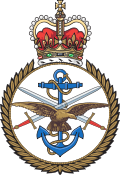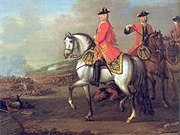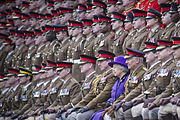Head of the British Armed Forces
| Commander-in-chief role | |
 Badge of the British Armed Forces | |
 | |
| British Armed Forces | |
| Vested in | Monarch of the United Kingdom |
|---|---|
| Style | Her Majesty |
| Formation | 1707 Union of Scotland and England |
The Head of the British Armed Forces,[1][2] also known as Commander-in-Chief of the British Armed Forces,[3][4][5][6] refers to the supreme command authority of the British Armed Forces, a military role vested in the monarch of the United Kingdom, currently Queen Elizabeth II. Under British constitutional law the command and government of the British armed forces is vested in the Queen and as such she holds the highest office in the military chain of command.[7] The authority to issue orders and give commands to military personnel is delegated by the Queen to her commanders in the Field; however, she does retain the right to issue orders personally.
Military Oath of allegiance[]
Before joining the military all recruits of the British Armed Forces (other than Ratings and Officers in the Royal Navy and Officers in the Royal Marines[8]) must take the following oath:
I... swear by Almighty God (do solemnly, and truly declare and affirm) that I will be faithful and bear true allegiance to Her Majesty Queen Elizabeth II, Her Heirs and Successors, and that I will, as in duty bound, honestly and faithfully defend Her Majesty, Her Heirs and Successors, in Person, Crown and Dignity against all enemies, and will observe and obey all orders of Her Majesty, Her Heirs and Successors, and of the General Officers (Air Officers if entering the RAF) and officers set over me.[7]
Long-standing constitutional convention, however, has vested de facto executive authority, by the exercise of Royal Prerogative, in the Prime Minister and Her Majesty's Secretary of State for Defence. The Prime Minister (acting with the Cabinet) makes the key political decisions on the use of the armed forces.[9]
The Queen, however, remains the supreme authority of the military.[2] As Commander-in-Chief the Queen closely follows developments in the armed forces and the security services. She regularly receives the agenda in advance of all cabinet meetings and its committees, particularly the national security committee.[10] She also receives the minutes of the meetings of all of these committees and all cabinet documents.[11]
The Queen regularly receives the Secretary of State for Defence in audience to discuss Defence documents and policies; if she requires, her Private Secretary can seek additional information from Defence departments.[12] Her Majesty also receives regular reports from the Chief of the General Staff, the First Sea Lord and Chief of the Naval Staff, and the Chief of Air Staff that cover all important developments in military matters.[13] Her Majesty further receives the Chief of the Defence Staff in audience to discuss tri-service military matters.[11]
Duties and Functions[]

In her capacity as Commander in Chief of the Armed Forces the Queen exercises the following powers, duties and functions on the advice of Her Majesty's Cabinet:[14][15]
Powers relating to armed forces, war and times of emergency
- Right to make war or peace or institute hostilities falling short of war
- Deployment and use of armed forces overseas
- Maintenance of the Royal Navy
- Use of the armed forces within the UK to maintain the peace in support of the police or otherwise in support of civilian authorities (e.g. to maintain essential services during a strike)
- The government and command of the armed forces is vested in Her Majesty
- Control, organisation and disposition of armed forces
- Requisition of British ships in times of urgent national necessity
- Commissioning of officers in all three armed forces
- Armed forces pay
- Crown's right to claim Prize (enemy ships or goods captured at sea)
- Regulation of trade with the enemy
- Crown's right of angary, in time of war, to appropriate the property of a neutral which is within the realm, where necessity requires
- Powers in the event of a grave national emergency, including those to enter upon, take and destroy private property
Defence Services Secretary of the Royal Household[]
The Defence Services Secretary is an officer of the Royal Household. The DSS is appointed by Royal Warrant from the three Services on a rotational basis.[16] The current occupant is Rear Admiral James Norman Macleod. He is the primary channel of communication between the Monarch, in her capacity as Commander-in-Chief of the Armed Forces, and the officers and commands of the British Armed Forces. His office provides the Monarch with the information and documentation related to defence affairs that she requires to perform her military functions. The office was created in 1964 by the Queen as part of the centralization of military affairs into a single defence ministry. The DSS maintains a direct link with the offices of the chiefs of staff of the Army, Navy and Air Force.[17] The Defence Services Secretary is responsible to the Queen, the Secretary of State for Defence and the Chief of the Defence Staff for tri-service military appointments and works with the Military Secretary, the Air Secretary and Naval Secretary. He submits the names of the officers nominated for promotion to the Queen through her private secretary. The Queen makes appointments to the ranks of rear-admiral, major-general, air vice-marshal and above directly.[7]
The Queen and Military Appointments[]
Under the Queen's regulations for the Army, Navy and Air Force, the Monarch is responsible for making a large number of appointments to senior military posts. Currently the Commander-in-Chief approves appointments at the two-star level and up. The names of the officers appointed to these and other posts in the armed forces are regularly published by the Ministry of Defence.[18][19]
Most military appointments are issued in the form of Letters Patent or a Royal Warrant, both are forms by which the royal will is expressed.[20] The Defence Council of United Kingdom is created by Letters Patent that also set out its powers and membership.[7] The Queen signs a royal warrant directing the issue of the Letters Patent and ordering the Great Seal of The Realm to be affixed to them. Letters patent are the most formal method of appointment and are used infrequently.[20]
The more frequent and simplest method of appointment is by Royal warrant signed by the Queen and her Secretary of State for Defence. The Secretary of State first makes an informal submission of the name of a candidate, after the Queen has signified her approval the Defence Ministry prepares the formal Warrant of Appointment. The Warrants (alongside all other Defence documentation) are sent at the end of each weekday to the Queen's Private Secretary by Dispatch box.[21] The Queen and the Secretary of State for Defence then sign the warrant.[16]
The Queen and the Ministry of Defence[]
The Ministry of Defence is the highest level military headquarters charged with formulating and executing defence policy for the Armed Forces; it employed 57,000 civilians in October 2017.[22]
The command authority of the Armed Forces flows from the Queen, in her capacity as commander-in-chief of the Armed Forces, to the various officers and councils of the defence ministry. The Monarch appoints the members of these committees to exercise day-to-day administration of Her Majesty's Armed Forces. The committees are the Defence Council, the Army Board, the Navy Board, the Air Force Board, the Defence Board[23] and the Chiefs of Staffs Committee. The Defence Council, composed of senior representatives of the services and the Ministry of Defence, provides the "formal legal basis for the conduct of defence" and is chaired by the Defence Secretary.[24][25]
[]
Each service branch of the Armed Forces maintains its own command staff that administers the affairs of its service.[18] The staffs receive their authority to act and to exercise command and control over their units from the Queen and her Defence Council.[7]
Until 2012 each of the three services also had one or more commands with a (four-star) commander-in-chief in charge of operations. These were, latterly: Commander-in-Chief Fleet (CINCFLEET – sharing a Command HQ with Commander-in-Chief Naval Home Command (CINCNAVHOME)), Commander-in-Chief, Land Forces (CINCLAND) and Commander-in-Chief Air (CINCAIR). (At one time there were many more Naval, Military and Air Commands, each with (in many cases) their own Commanders-in-Chief.) Since 2012, however, full operational command has been vested in the three Chiefs of Staff, and the appointment of distinct Commanders-in-Chief has been discontinued. This change was implemented in response to the 2011 Levene report, which advised that it would serve to "streamline top-level decision-making, simplify lines of accountability... remove duplication between the posts and also provide impetus to the leaning of the senior leadership".[26]

King George II at the Battle of Dettingen in 1743, by John Wootton. It remains the last time a British monarch personally led his troops into battle.

King George V inspecting the British 29th Division prior to the division's departure for Gallipoli in 1915. The division commander, Major General Aylmer Hunter-Weston, rides alongside the King at the right of the photo.

Queen Elizabeth II posing for a photograph with soldiers from the Household Cavalry, at Combermere Barracks in 2012.

A warning sign posted "By Command of the Defence Council".
Commander-in-Chief of Bermuda[]
In the colonies of the English Empire, and subsequently the British Empire, the duties of lords-lieutenant were generally performed by the commander-in-chief or the governor. Both offices may have been occupied by the same person. Attempts to rekindle the militia without a Militia Act or funds from the colonial government were made throughout the 19th century under the authorisation of the governor and commander-in-chief, but none proved lasting. The colonial government was finally compelled to raise militia and volunteer forces (the Bermuda Militia Artillery and the Bermuda Volunteer Rifle Corps by act in the 1890s (the Bermuda Cadet Corps, Bermuda Volunteer Engineers, and Bermuda Militia Infantry were added at later dates), and these fell under the governor and commander-in-chief, as well as under operational control of his junior, the brigadier in charge of the Bermuda Command (or Bermuda Garrison, which included the regular as well as the part-time military (as opposed to naval) forces in the colony. Although the Royal Naval and the regular army establishments have been withdrawn from Bermuda, the Governor of Bermuda remains the commander-in-chief (though most recent officeholders have not been career army officers) of the Royal Bermuda Regiment (a 1965 amalgam of the BMA and BVRC, which had both been re-organised in line with the Territorial Army after the First World War).[27][28]
See also[]
- Colonel-in-Chief
- Commander-in-chief
- British Empire
References[]
- ^ Kirsty.Oram (9 January 2017). "The Queen and the Armed Forces". The Royal Family. Retrieved 19 August 2020.
- ^ "Prince Charles promoted to top military rank". Times of Malta. Retrieved 2 August 2020.
- ^ "The Queen talks to military personnel in her second video call • The Crown Chronicles". The Crown Chronicles. 14 July 2020. Retrieved 1 August 2020.
- ^ "A message from Her Majesty The Queen on Armed Forces Day". The Royal Family. 26 June 2020. Retrieved 30 July 2020.
- ^ "The Queen's heartfelt thanks to military personnel and veterans on Armed Forces Day - read in full". HELLO!. 26 June 2020. Retrieved 29 July 2020.
- ^ a b c d e "The Queens Regulations for the Army" (PDF). Ministry of Defence. Retrieved 7 July 2020.
- ^ "Commanding officers guide (manual of service law: JSP 830 volume 1), Chapter 18" (PDF). www.gov.uk. 31 January 2011. Retrieved 19 December 2016.
- ^ Governance of Britain, July 2007. Retrieved on 12 May 2013.
- ^ Publisher HMSO. Aspects of Britain, the monarchy.
- ^ a b Hardman, Robert. A year with the Queen.
- ^ Aspects of Britain, the monarchy. HMSO. p. 27.
- ^ Aspects of Britain, the monarchy. HMSO. pp. 29, 30.
- ^ "Mystery lifted on Queen's powers". The Guardian. 21 October 2003. Retrieved 11 July 2020.
- ^ Review of the Royal Prerogative Powers: Final Report, Ministry of Justice, October 2009, page 32, Retrieved on 12 May 2013.
- ^ a b The Royal Encyclopedia. Macmillan Press. p. 23.
- ^ The Royal Encyclopedia. McMillan press. pp. 141, 142.
- ^ a b "Ministry of Defence". GOV.UK. Retrieved 12 July 2020.
- ^ "Ministry of Defence and Tri-Service senior appointments" (PDF). Retrieved 30 July 2020.
- ^ a b The Royal Encyclopedia. Macmillan Press. pp. 312, 487, 23.
- ^ The Royal Encyclopedia. Macmillan Press. p. 56.
- ^ "Data" (PDF). 2017. Retrieved 12 November 2019.
- ^ "Our governance". GOV.UK. Retrieved 24 March 2019.
- ^ Defence Organisation, mod.uk
- ^ Defence Council and Chief of the Defence Staff, armedforces.co.uk
- ^ "An independent report into the structure and management of the Ministry of Defence" (PDF).
- ^ travis.smith-simons (3 March 2016). "The Governor of Bermuda". www.gov.bm.
- ^ "The Good Governor. Biographic article on Major General Sir William Reid KCB, FRS, Governor and Commander-in-Chief of Bermuda from 1839 to 1846. The Bermudian magazine". Archived from the original on 14 November 2017. Retrieved 2 September 2018.
- British Armed Forces
- British monarchy
- Government of the United Kingdom
- Commanders in chief



